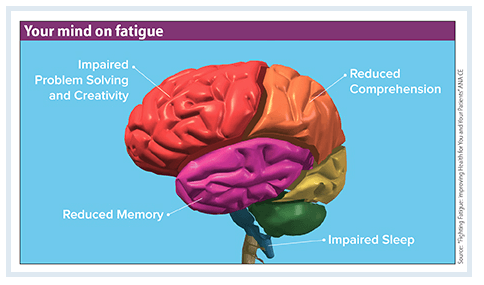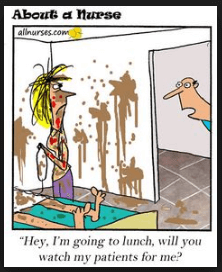For many of us outside nursing, taking a break in the workday—to grab a bite, go for a walk, or catch up with a coworker—is a practiced habit. It’s something we take for granted. Not so for nurses.

Our VP of Nursing recalls the predicament he faced on most shifts: He was unable to take an uninterrupted break, but there was also no permissible place to drink water at the nurses’ station. It’s ironic that those entrusted to keep the rest of us comfortable, rested, and fed aren’t afforded the same courtesy—especially in a field where nurse fatigue and patient safety are so closely linked.
Long shifts in nursing are standard practice. What’s not so common is the routine of taking a short break to unplug and recharge during those long workdays. Research shows that the more hours a nurse works in a shift, the less likely he or she may be to escape call lights or other patient needs. In one study:
“… nearly 40 percent of nurses surveyed worked shifts longer than 12 hours, but the long workdays were not associated with an ability to enjoy a rest period. In fact, the numbers went down. Forty-nine percent of nurses working shifts of 8.5 or fewer hours were able to escape patient-care duties during a break, compared with 46.7 percent working shifts of 12.5 hours or more. And the percentage of breaks free of patient-care duties decreased to 30 percent when nurses worked 20 or more consecutive hours.”
Statistics like this aren’t too surprising, given the character of those drawn to nursing in the first place. Nurses tend to prioritize others’ needs. Vanessa Patricelli, an orthopedics nurse at Harborview Medical Center in Seattle, says, “We tend to put our patients’ needs first before we sit down, go to the bathroom, or grab a bite to eat. At the end of the day, we’re exhausted with the added weight of knowing we face the same challenges tomorrow.”
There’s also a stigma that surrounds taking a break. Coworkers may frown on it, creating peer pressure to dissuade the habit. And many employers still expect nurses to keep working during lunch breaks that they’re not paid for, as evidenced by the string of lawsuits filed against such practices. Higher patient acuity and an increasing shortage of nurses are contributing to this hamster-wheel pace as well.
Still, there’s ample research showing how important it is to give the brain and body some downtime. John P. Trougakos, an assistant management professor at the University of Toronto Scarborough and the Rotman School of Management, explains,
“Mental concentration is similar to a muscle. It becomes fatigued after sustained use and needs a rest period before it can recover, he explains—much as a weightlifter needs rest before doing a second round of repetitions at the gym.”
Studies show that when nurses log long hours without breaks, they’re also more prone to injuries, which take a financial toll on the facility as well:
“Adverse schedules such as work days longer than 13 hours, weekend work, working without breaks, returning to work on days off, on-call work, and overtime have all been found to relate significantly to the incidence of musculoskeletal injury in nurses. These same schedule characteristics have also been found to be significantly related to the incidence of needlestick injuries among nurses.”
Industries outside health care have been quicker to adopt measures to address fatigue in shift workers. Measures taken to support airline crews could inspire nursing, including limiting time on duty, mandating opportunities for sleep, and using controlled rest periods. Ultimately, as the saying goes, “what’s good for the goose is good for the gander.” In other words, when nurses are rested and rejuvenated, patients in their care benefit, as do facility leaders looking to maximize reimbursements—a topic we explored in an earlier blog post.
Here are some ways nurse managers can help their staff get some much-needed relief:
- Adapt Staffing Levels: Much of the time, nurses don’t take breaks because they don’t have anyone to cover for them.
 Balancing nurse-to-patient ratios with budget demands is a challenge. Giving nurses the relief they need, though, will improve retention and patient care, factors that ultimately bode well for the bottom line too. Technology like Nursegrid can help you quickly summon on-call staff members and fill open shifts with more targeted requests that available staff are more likely to pick up, helping you maintain appropriate staffing levels with the team you do have.
Balancing nurse-to-patient ratios with budget demands is a challenge. Giving nurses the relief they need, though, will improve retention and patient care, factors that ultimately bode well for the bottom line too. Technology like Nursegrid can help you quickly summon on-call staff members and fill open shifts with more targeted requests that available staff are more likely to pick up, helping you maintain appropriate staffing levels with the team you do have. -
Structure Breaks: Setting up the work environment to permit and encourage downtime is critical. Ensuring you have the proper staffing levels in place is critical (#1), but committing to changing the work environment is also important. A group of nurses at Harborview Medical Center in Seattle did just that recently. The results of their pilot program to add four full-time nurses to two acute-care units–which allowed two relief nurses to cover the patient care assignments of staff nurses while they took real, uninterrupted breaks–included increased nurse satisfaction, a sharp decline in patient falls and medication errors, and dramatically improved nurse retention rates. The results were so significant that the relief nurses became part of the units’ regular staffing plan.
-
Promote Communication: Encourage your nurses to ask for help. Instead of feeling like they need to carry a burgeoning load on their own, they should feel supported. By helping them delegate during especially hectic times, they’ll have more room to recharge.
-
Set Up a Nap Room: NASA studies on sleep-deprived military pilots and astronauts found that a 40-minute power nap improved performance by 34 percent and alertness by 100%. In another study that looked at napping on breaks during night shifts, “10 out of 13 critical care nurses who napped regularly during breaks reported several benefits to naps, including improved energy, mood and decision-making, and vigilance.” Naturally, it might take some work to convince senior management to allow sleeping on a shift. Suggesting a pilot program will likely help them see the benefits are far-reaching.
Are you and your staff taking breaks? If no, why not? And if you are, we’d love to hear how you’re making it work. Share in the comments below or feel free to give us a shout at hello@nursegrid.com.
